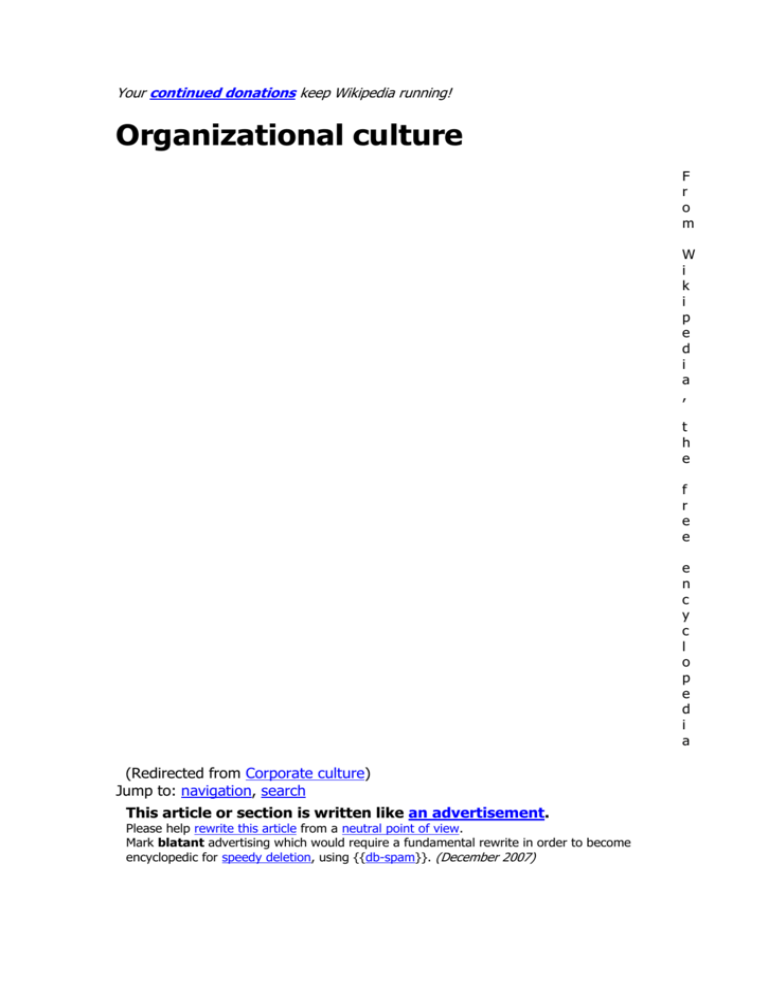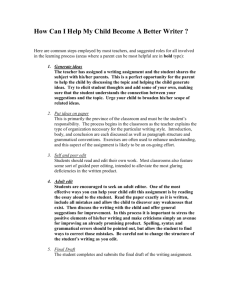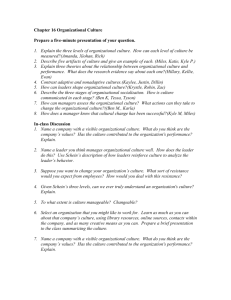Your continued donations keep Wikipedia running
advertisement

Your continued donations keep Wikipedia running!
Organizational culture
F
r
o
m
W
i
k
i
p
e
d
i
a
,
t
h
e
f
r
e
e
e
n
c
y
c
l
o
p
e
d
i
a
(Redirected from Corporate culture)
Jump to: navigation, search
This article or section is written like an advertisement.
Please help rewrite this article from a neutral point of view.
Mark blatant advertising which would require a fundamental rewrite in order to become
encyclopedic for speedy deletion, using {{db-spam}}. (December 2007)
Organizational culture, or corporate culture, comprises the attitudes,
experiences, beliefs and values of an organization. It has been defined as "the
specific collection of values and norms that are shared by people and groups
in an organization and that control the way they interact with each other and
with stakeholders outside the organization. Organizational values are beliefs
and ideas about what kinds of goals members of an organization should
pursue and ideas about the appropriate kinds or standards of behavior
organizational members should use to achieve these goals. From
organizational values develop organizational norms, guidelines or expectations
that prescribe appropriate kinds of behavior by employees in particular
situations and control the behavior of organizational members towards one
another"[1]Senior management may try to determine a corporate culture.
They may wish to impose corporate values and standards of behavior that
specifically reflect the objectives of the organization. In addition, there will
also be an extant internal culture within the workforce. Work-groups within
the organization have their own behavioral quirks and interactions which, to
an extent, affect the whole system. Task culture can be imported. For
example, computer technicians will have expertise, language and behaviors
gained independently of the organization, but their presence can influence the
culture of the organization as a whole.
Contents
[hide]
1 Strong/weak cultures
2 Classification schemes
o 2.1 Geert Hofstede
o 2.2 Deal and Kennedy
o 2.3 Charles Handy
o 2.4 Edgar Schein
3 Elements
4 Organizational culture and change
5 Entrepreneurial culture
6 Critical views
7 Measurement
8 See also
9 Notes
10 References
11 External links
[edit] Strong/weak cultures
Strong culture is said to exist where staff respond to stimulus because of
their alignment to organizational values.
Conversely, there is weak culture where there is little alignment with
organizational values and control must be exercised through extensive
procedures and bureaucracy.
Where culture is strong—people do things because they believe it is the right
thing to do—there is a risk of another phenomenon, Groupthink. "Groupthink"
was described by Irving L. Janis. He defined it as "...a quick and easy way to
refer to a mode of thinking that people engage when they are deeply involved
in a cohesive ingroup, when members' strivings for unanimity override their
motivation to realistically appraise alternatives of action." This is a state
where people, even if they have different ideas, do not challenge
organizational thinking, and therefore there is a reduced capacity for
innovative thoughts. This could occur, for example, where there is heavy
reliance on a central charismatic figure in the organization, or where there is
an evangelical belief in the organization’s values, or also in groups where a
friendly climate is at the base of their identity (avoidance of conflict). In fact
groupthink is very common, it happens all the time, in almost every group.
Members that are defiant are often turned down or seen as a negative
influence by the rest of the group, because they bring conflict.
Innovative organizations need individuals who are prepared to challenge the
status quo—be it groupthink or bureaucracy, and also need procedures to
implement new ideas effectively.
[edit] Classification schemes
Several methods have been used to classify organizational culture. Some are
described below:
[edit] Geert Hofstede
Geert Hofstede[2] demonstrated that there are national and regional cultural
groupings that affect the behavior of organizations. Hofstede identified five
dimensions of culture in his study of national influences:Power distance - The
degree to which a society expects there to be differences in the levels of
power. A high score suggests that there is an expectation that some
individuals wield larger amounts of power than others. A low score reflects
the view that all people should have equal rights. Uncertainty avoidance
reflects the extent to which a society accepts uncertainty and risk.
individualism vs. collectivism - individualism is contrasted with collectivism,
and refers to the extent to which people are expected to stand up for
themselves, or alternatively act predominantly as a member of the group or
organization. However, recent researches have shown that high individualism
may not necessarily mean low collectivism, and vice versa. Research indicates
that the two concepts are actually unrelated. Some people and cultures might
have both high individualism and high collectivism, for example. Someone
who highly values duty to his or her group does not necessarily give a low
priority to personal freedom and self-sufficiency Masculinity vs. femininity refers to the value placed on traditionally male or female values. Male values
for example include competitiveness, assertiveness, ambition, and the
accumulation of wealth and material possessions. Long vs. short term
orientation - describes a society's "time horizon," or the importance attached
to the future versus the past and present. In long term oriented societies,
thrift and perseverance are valued more; in short term oriented societies,
respect for tradition and reciprocation of gifts and favors are valued more.
Eastern nations tend to score especially high here, with Western nations
scoring low and the less developed nations very low; China scored highest
and Pakistan lowest.
[edit] Deal and Kennedy
Deal and Kennedy[3] defined organizational culture as the way things get done
around here. They measured organizations in respect of:Feedback - quick
feedback means an instant response. This could be in monetary terms, but
could also be seen in other ways, such as the impact of a great save in a
soccer match. Risk - represents the degree of uncertainty in the
organization’s activities. Using these parameters, they were able to suggest
four classifications of organizational culture:The Tough-Guy Macho
Culture. Feedback is quick and the rewards are high. This often applies to
fast moving financial activities such as brokerage, but could also apply to a
police force, or athletes competing in team sports. This can be a very stressful
culture in which to operate. The Work Hard/Play Hard Culture is
characterized by few risks being taken, all with rapid feedback. This is typical
in large organizations, which strive for high quality customer service. It is
often characterized by team meetings, jargon and buzzwords. The Bet your
Company Culture, where big stakes decisions are taken, but it may be
years before the results are known. Typically, these might involve
development or exploration projects, which take years to come to fruition,
such as oil prospecting or military aviation. The Process Culture occurs in
organizations where there is little or no feedback. People become bogged
down with how things are done not with what is to be achieved. This is often
associated with bureaucracies. While it is easy to criticize these cultures for
being overly cautious or bogged down in red tape, they do produce consistent
results, which is ideal in, for example, public services.
[edit] Charles Handy
Charles Handy[4] (1985) popularized a method of looking at culture which
some scholars have used to link organizational structure to Organizational
Culture. He describes:a Power Culture which concentrates power among a
few. Control radiates from the center like a web. Power Cultures have few
rules and little bureaucracy; swift decisions can ensue. In a Role Culture,
people have clearly delegated authorities within a highly defined structure.
Typically, these organizations form hierarchical bureaucracies. Power derives
from a person's position and little scope exists for expert power. By contrast,
in a Task Culture, teams are formed to solve particular problems. Power
derives from expertise as long as a team requires expertise. These cultures
often feature the multiple reporting lines of a matrix structure. A Person
Culture exists where all individuals believe themselves superior to the
organization. Survival can become difficult for such organizations, since the
concept of an organization suggests that a group of like-minded individuals
pursue the organizational goals. Some professional partnerships can operate
as person cultures, because each partner brings a particular expertise and
clientele to the firm.
[edit] Edgar Schein
Edgar Schein,[5] an MIT Sloan School of Management professor, defines
organizational culture as "the residue of success" within an organization.
According to Schein, culture is the most difficult organizational attribute to
change, outlasting organizational products, services, founders and leadership
and all other physical attributes of the organization. His organizational model
illuminates culture from the standpoint of the observer, described by three
cognitive levels of organizational culture.
At the first and most cursory level of Schein's model is organizational
attributes that can be seen, felt and heard by the uninitiated observer.
Included are the facilities, offices, furnishings, visible awards and recognition,
the way that its members dress, and how each person visibly interacts with
each other and with organizational outsiders.
The next level deals with the professed culture of an organization's members.
At this level, company slogans, mission statements and other operational
creeds are often expressed, and local and personal values are widely
expressed within the organization. Organizational behavior at this level usually
can be studied by interviewing the organization's membership and using
questionnaires to gather attitudes about organizational membership.
At the third and deepest level, the organization's tacit assumptions are found.
These are the elements of culture that are unseen and not cognitively
identified in everyday interactions between organizational members.
Additionally, these are the elements of culture which are often taboo to
discuss inside the organization. Many of these 'unspoken rules' exist without
the conscious knowledge of the membership. Those with sufficient experience
to understand this deepest level of organizational culture usually become
acclimatized to its attributes over time, thus reinforcing the invisibility of their
existence. Surveys and casual interviews with organizational members cannot
draw out these attributes--rather much more in-depth means is required to
first identify then understand organizational culture at this level. Notably,
culture at this level is the underlying and driving element often missed by
organizational behaviorists.
Using Schein's model, understanding paradoxical organizational behaviors
becomes more apparent. For instance, an organization can profess highly
aesthetic and moral standards at the second level of Schein's model while
simultaneously displaying curiously opposing behavior at the third and
deepest level of culture. Superficially, organizational rewards can imply one
organizational norm but at the deepest level imply something completely
different. This insight offers an understanding of the difficulty that
organizational newcomers have in assimilating organizational culture and why
it takes time to become acclimatized. It also explains why organizational
change agents usually fail to achieve their goals: underlying tacit cultural
norms are generally not understood before would-be change agents begin
their actions. Merely understanding culture at the deepest level may be
insufficient to institute cultural change because the dynamics of interpersonal
relationships (often under threatening conditions) are added to the dynamics
of organizational culture while attempts are made to institute desired change.
[edit] Elements
G. Johnson[6] described a cultural web, identifying a number of elements that
can be used to describe or influence Organizational Culture:The Paradigm:
What the organization is about; what it does; its mission; its values. Control
Systems: The processes in place to monitor what is going on. Role cultures
would have vast rulebooks. There would be more reliance on individualism in
a power culture. Organizational Structures: Reporting lines, hierarchies,
and the way that work flows through the business. Power Structures: Who
makes the decisions, how widely spread is power, and on what is power
based? Symbols: These include organizational logos and designs, but also
extend to symbols of power such as parking spaces and executive
washrooms. Rituals and Routines: Management meetings, board reports
and so on may become more habitual than necessary. Stories and Myths:
build up about people and events, and convey a message about what is
valued within the organization. These elements may overlap. Power structures
may depend on control systems, which may exploit the very rituals that
generate stories which may not be true.
[edit] Organizational culture and change
Burman and Evans (2008) argue that it is 'leadership' that affects culture
rather than 'management', and describe the difference[7]. When one wants to
change an aspect of the culture of an organization one has to keep in
consideration that this is a long term project. Corporate culture is something
that is very hard to change and employees need time to get used to the new
way of organizing. For companies with a very strong and specific culture it will
be even harder to change.
Cummings & Worley (2005, p. 491 – 492) give the following six guidelines for
cultural change, these changes are in line with the eight distinct stages
mentioned by Kotter (1995, p. 2)3:1. Formulate a clear strategic vision (stage
1,2 & 3 of Kotter, 1995, p. 2) In order to make a cultural change effective a
clear vision of the firm’s new strategy, shared values and behaviours is
needed. This vision provides the intention and direction for the culture change
(Cummings & Worley, 2005, p.490).2. Display Top-management commitment
(stage 4 of Kotter, 1995, p. 2) It is very important to keep in mind that
culture change must be managed from the top of the organization, as
willingness to change of the senior management is an important indicator
(Cummings & Worley, 2005, page 490). The top of the organization should be
very much in favour of the change in order to actually implement the change
in the rest of the organization. De Caluwé & Vermaak (2004, p 9) provide a
framework with five different ways of thinking about change.3. Model culture
change at the highest level (stage 5 of Kotter, 1995, p. 2) In order to show
that the management team is in favour of the change, the change has to be
notable at first at this level. The behaviour of the management needs to
symbolize the kinds of values and behaviours that should be realized in the
rest of the company. It is important that the management shows the
strengths of the current culture as well, it must be made clear that the
current organizational does not need radical changes, but just a few
adjustments. (See for more: (Deal & Kennedy, 1982; Sathe, 1983; Schall;
1983; Weick, 1985; DiTomaso, 1987)4. Modify the organization to support
organizational change The fourth step is to modify the organization to support
organizational change.5. Select and socialize newcomers and terminate
deviants (stage 7 & 8 of Kotter, 1995, p. 2) A way to implement a culture is
to connect it to organizational membership, people can be selected and
terminate in terms of their fit with the new culture (Cummings & Worley,
2005, p. 491).6. Develop ethical and legal sensitivity Changes in culture can
lead to tensions between organizational and individual interests, which can
result in ethical and legal problems for practitioners. This is particularly
relevant for changes in employee integrity, control, equitable treatment and
job security (Cummings & Worley, 2005, p. 491).
[edit] Entrepreneurial culture
Stephen McGuire[8] defined and validated a model of organizational culture
that predicts revenue from new sources. An Entrepreneurial Organizational
Culture (EOC) is a system of shared values, beliefs and norms of members of
an organization, including valuing creativity and tolerance of creative people,
believing that innovating and seizing market opportunities are appropriate
behaviors to deal with problems of survival and prosperity, environmental
uncertainty, and competitors’ threats, and expecting organizational members
to behave accordingly.
[edit] Critical views
Writers from Critical management studies have tended to express skepticism
about the functionalist and unitarist views of culture put forward by
mainstream management thinkers. Whilst not necessarily denying that
organizations are cultural phenomena, they would stress the ways in which
cultural assumptions can stifle dissent and reproduce management
propaganda and ideology. After all, it would be naive to believe that a single
culture exists in all organizations, or that cultural engineering will reflect the
interests of all stakeholders within an organization. In any case, Parker[9] has
suggested that many of the assumptions of those putting forward theories of
organizational culture are not new. They reflect a long-standing tension
between cultural and structural (or informal and formal) versions of what
organizations are. Further, it is perfectly reasonable to suggest that complex
organizations might have many cultures, and that such sub-cultures might
overlap and contradict each other. The neat typologies of cultural forms found
in textbooks rarely acknowledge such complexities, or the various economic
contradictions that exist in capitalist organizations.
One of the strongest and widely recognised criticisms of theories that attempt
to categorise or 'pigeonhole' organisational culture is that put forward by
Linda Smircich. She uses the metaphor of a plant root to represent culture,
describing that it drives organisations rather than vice versa. Organisations
are the product of organisational culture, we are unaware of how it shapes
behaviour and interaction (also recognised through Scheins (2002) underlying
assumptions) and so how can we categorise it and define what it is?
[edit] Measurement
Despite the evidence suggesting their potential usefulness, organisational
climate metrics have not been fully exploited as leading safety, health and
environmental performance indicators and as an aid to relative risk ranking.
Dodsworth et al.[10] are the first researchers to have successfully used PLS
modelling techniques to correlate organizational climate metrics with an
organisation’s safety performance. Further information regarding this research
can be obtained from the following link Dodsworth's Homepage
In the context of effectiveness, the repertory grid interview can be used to
capture a representation of an organisation's culture or corporate culture - the
organisation's construct system. The repertory grid interview process provides
a structured way of comparing effective and less effective performance and
capturing it in the interviewee's words without imposing someone else's
model or way of thinking.
[edit] See also
Institutional memory Organizational climate Organizational learning
Prometheus Process
[edit] Notes
^ Charles W. L. Hill, and Gareth R. Jones, (2001) Strategic Management. Houghton
Mifflin. ^ Hofstede, G. (1980) Culture's Consequences: International Differences in
Work Related Values, Beverly Hills, CA, Sage Publications ^ Deal T. E. and Kennedy,
A. A. (1982) Corporate Cultures: The Rites and Rituals of Corporate Life,
Harmondsworth, Penguin Books. ^ Handy, C.B. (1985) Understanding Organizations,
3rd Edn, Harmondsworth, Penguin Books ^ Schein, E.H. (1985-2005) Organizational
Culture and Leadership, 3rd Ed., Jossey-Bass ISBN 0-7879-7597-4 ^ Johnson, G.
(1988) "Rethinking Incrementalism", Strategic Management Journal Vol 9 pp75-91 ^
Burman, R. & Evans, A.J. (2008) Target Zero: A Culture of safety, Defence Aviation
Safety Centre Journal 2008, 22-27. http://www.mod.uk/NR/rdonlyres/849892B2-D6D24DFD-B5BD-9A4F288A9B18/0/DASCJournal2008.pdf ^ McGuire, Stephen J.J. (2003).
Entrepreneurial Organizational Culture: Construct Definition and Instrument
Development and Validation, Ph.D. Dissertation, The George Washington University,
Washington, DC. ^ Parker, M. (2000) Organizational Culture and Identity, London:
Sage. ^ Dodsworth M. et al (2007) Organizational Climate Metrics As Safety, Health
and Environment Performance Indicators And An Aid To Relative Risk Ranking Within
Industry. Process Safety and Environmental Protection, Trans IChemE, Vol 85 (B1)
59-69, Part B, January.
[edit] References
Black, Richard J. (2003) Organisational Culture: Creating the Influence
Needed for Strategic Success, London UK, ISBN 1-58112-211-X Cummings,
Thomas G. & Worley, Christopher G. (2005), Organization Development and
Change, 8th Ed., Thomson South-Western, USA, ISBN 0324260601 Kotter,
John. 1992 Corporate Culture and Performance, Free Press; (April 7, 1992)
ISBN 0-02-918467-3 O'Donovan, Gabrielle (2006). The Corporate Culture
Handbook: How to Plan, Implement and Measure a Successful Culture
Change Programme, The Liffey Press, ISBN 1-904148-97-2 Phegan, B. (19962000) Developing Your Company Culture, A Handbook for Leaders and
Managers, Context Press, ISBN 0-9642205-0-4 Stoykov, Lubomir. 1995
Corporate culture and communication, Stopanstvo , Sofia.






